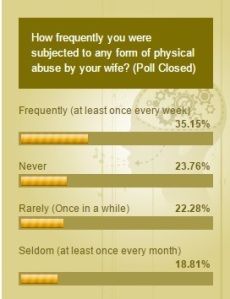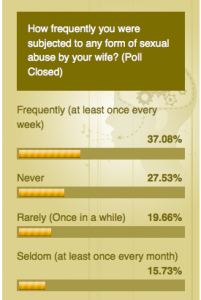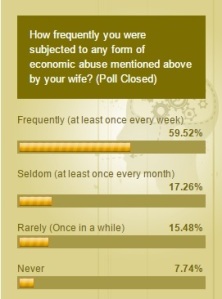On November 10, 2014, the United Nations Population Fund (UNFPA) published the report “Masculinity, Intimate Partner Violence and Son Preference in India,” a study in collaboration with the International Centre for Research on Women (ICRW). This report presents findings from a large-scale survey and includes many shocking revelations about intimate partner violence (IPV) in India and how UN groups deal with the issue. However, this article will focus only on the issue of IPV covered in this report.
To establish context, the report claims that “India … has high levels of violence against women.” So, from this we are to understand that the study was based on the presumption that Indian women are the victims of domestic violence and Indian men are the perpetrators.
To support this claim, the report refers to studies done on this issue by Campbell in 2002 and the National Family Health Survey (NFHS) in 2005-06. However, an earlier article already proved how previous domestic violence studies done in India were biased.
In order to bolster their claim this time, though, UNFPA provided statistical analysis and chi-square tests to make this report even more complicated for the general public to understand. However, the basic premise about the perpetrator in the study remained clear.
To further establish context, the report states that Indian culture makes people believe that “men’s dominance over women is normal and acts of violence against women are justified.” Ironically, we see that the survey results also find the same. We understand that the intention behind conducting this survey was to prove that India has got a messed-up society and culture that encourages violence against women by men. So the researchers started with a negative mindset about India and went on to prove the same. They also made men criminals even before they tried to prove in an unbiased manner by their research that men are the perpetrators.
The report also shows how flawlessly statistical sampling was done, keeping in mind the different socioeconomic and geographical factors. But let’s sidestep all that demographic jargon and go directly to the report’s findings of the survey on IPV.
Ironically, even in this IPV survey, they have captured information about dowry in marriages:
Also, the survey specifically mentions the religion of respondents: “A majority of men (82%) and women (79%) in the sample were Hindu.” Or, in other words, the survey findings show that mostly Hindu men are cruel to their wives. (Hindus, take note: The UN is again trying to malign your religion.)
The graph below provides an interesting perspective:
It shows that approximately one-third of the men surveyed did not have any partners. So out of a total 9,205 men surveyed, the effective survey was from 6,159 men; and out of 3,158 women, the effective survey was from 2,627 women. The assumption here is that if they had no partner, there was no question of them experiencing IPV.
In an effort to investigate the key determinants that cause violence, the report tried to examine economic stress: “To explore characteristics that may affect men’s attitudes and behavior, we also asked men specific questions about their work-related stress or depression. Given the prevailing social expectation to perform the role of a breadwinner in the family, economic stress is identified as an indicator….” So, in a way, this report agrees that men do have reason to be under stress and that the pressure of being a breadwinner is huge.
The above table shows us how men are pushed into a corner by society to be breadwinners for the family and how this can lead to a disaster situation in a poor country like India. (The last four questions were asked of men who were not currently working.)
Overall, 55% of men reported economic stress:
The study also tried to capture the harassment faced by an individual in his or her childhood:
The results show that a total of 88% of women and 86% of men have reported some form of abuse in childhood. This is contrary to our belief that ONLY women suffer from discrimination in India.
This study goes on to measure the relationship control behavior of Indian men (Note: Again this study wanted to know how MEN control relationships and NOT vice versa—a study designed with bias):
Observe the nature of the questions asked and you will easily be able to understand that if these questions were asked the other way (e.g., My wife always wants to know where I am, etc.), the responses would have been the same. But since the questions were asked this way, it confirms that the survey had only one goal: to show that Indian men are control freaks.
In section 5.1, which outlines the extent of IPV in people’s lives, the report states, “In the study, both men and women who have or ever had a spouse/partner were asked a series of questions to assess the prevalence of intimate partner violence…. Men were asked ‘Have you ever …’ and women were asked ‘has a current or previous partner ever.…’”
Please find the questions asked below:
Please note that the surveyors never tried to measure IPV against men by women. The questions considered only men as perpetrators and women as victims. So, in the first place, we understand that the survey was never neutral and unbiased.
Please note the results given below—based on data representing whether a WOMAN (not a man) had experienced such violence in her marital lifetime:
However, a similar survey done by other NGOs in India, which focused on IPV experienced by men, revealed:
Also, in terms of frequency of violence, this report shows the nature of violence in the past six months as:
But again, this was captured in gender-biased way. In the recent survey conducted by other NGOs in India mentioned above, the same domestic violence picture is captured for Indian men, finding that 78% of men who took the survey were subjected to emotional abuse by their wives (as also mentioned, the latest UNFPA survey failed to capture the men’s side of story):
Similarly, the survey showed the following results for other abuses.
35% of men reported frequent physical abuse by their wives:
37% of men reported frequent sexual abuse against them:
About 60% of men reported economic abuse by their wives:
In section 5.2 of the UNFPA report, it states: “Intimate partner violence perpetrated by men and experienced by women … is considered as one of the main outcomes of masculinity in this analysis.”
We understand that when only a one-sided study is done, then the outcomes of such a report become invalid.
This report goes on to prove that if a man is abused as a child, he is more likely to become violent in his adulthood:
If we believe this data, then we understand that if men are doing more violence (as claimed by this study), then clearly it is the Indian boys who are abused more compared to the girls. However, we still do not see any separate ministry for men and boys to take care of their issues.
From this UNFPA report, we understand that this study never had an unbiased or neutral approach toward the issue of IPV. The study was conducted with the presumption that a man is always the perpetrator of IPV and a woman is always the victim of IPV. So no matter how much statistical analysis it includes, all its analogy falls flat since the researchers never even considered the other side of the issue. It is thus evident that this is just another effort of the UN to shame India and break up Indian families. Indian media houses that reported the study’s results only highlighted one side of the violence and never tried to investigate into the matter to uphold the truth to the nation. This shows how poorly Indian media is performing today.
The significance of this report being published just before International Men’s Day (IMD) on November 19 once again points to the dire need to set up a Men’s Commission and a Men’s Welfare Ministry to challenge the creation of such bias by international organizations against Indian men and boys. Otherwise, the future for our boys will be doomed forever.
Celebrate International Men’s Day (IMD) on November 19
This article was originally published here. –Eds
















